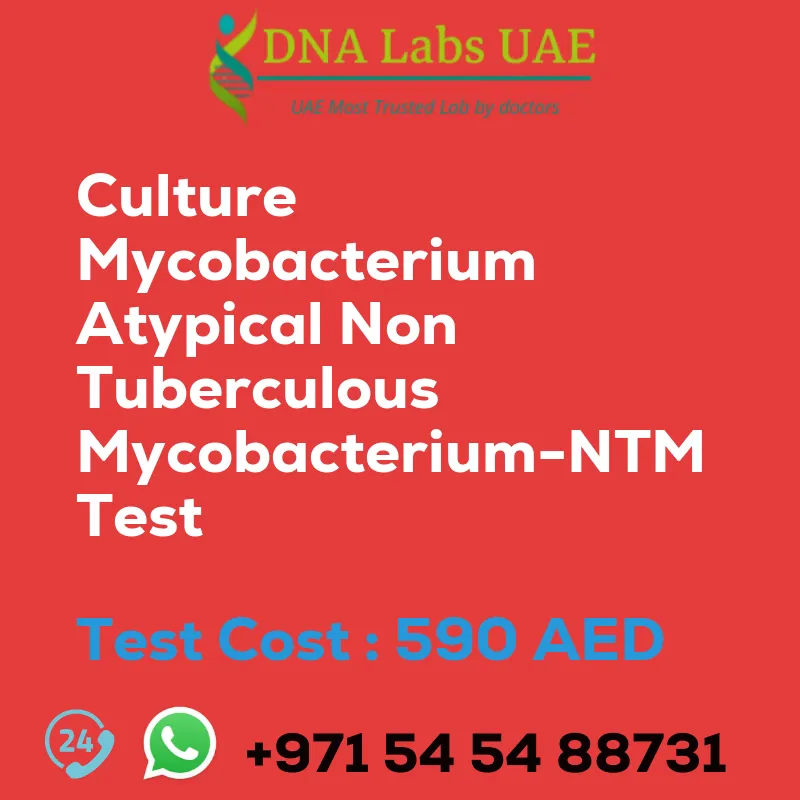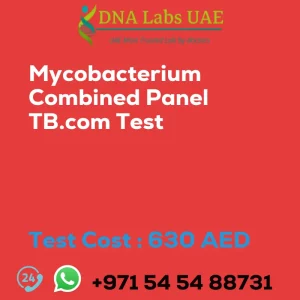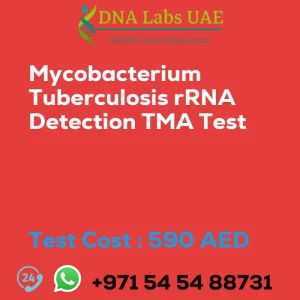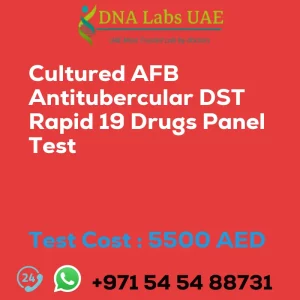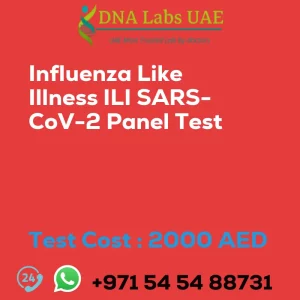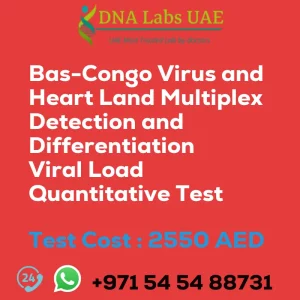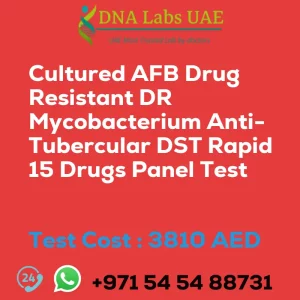CULTURE MYCOBACTERIUM ATYPICALNON TUBERCULOUS MYCOBACTERIUM-NTM Test
Test Name: CULTURE MYCOBACTERIUM ATYPICALNON TUBERCULOUS MYCOBACTERIUM-NTM Test
Components: Does not include ANTIBIOTIC SENSITIVITY
Price: 590.0 AED
Sample Condition:
- Blood/Bone Marrow: Collect 8 mL (5 mL min.) Blood/Bone marrow in Myco F / Lytic bottle available from LPL. Mix by gentle inversion 8-10 times. Ship at 18-22°C.
- CSF: Collect 2 mL (1 mL min.) CSF in a Red Top (No Additive) tube or sterile screw capped container. Do not use SST gel barrier tubes. Ship refrigerated.
- Pus/Body fluids (Pleural/Pericardial/Ascitic/Synovial/Ocular) Aspirates/Semen/BAL Bronchial washings: Submit as much as possible (1 mL min.) in a sterile screw capped container. Ship refrigerated.
- Endometrial curettings/Tissue: Submit in sterile normal saline in a sterile screw capped container. Ship refrigerated.
- Swabs: Submit swabs in 1 mL sterile normal saline in sterile screw capped container. Ship refrigerated.
- Sputum/Urine: Submit 2 Spot (random) morning samples, 5-10 mL (1 mL min.) sputum / 10 mL (5 mL min.) urine in a sterile screw capped container. Do not pool the samples. Ship refrigerated.
- Gastric Lavage: Submit 5-10 mL (2 mL min.) gastric lavage in a sterile screw capped container. Ship refrigerated. Overnight fasting is mandatory.
Report Delivery: Sample Daily by 3.30 pm; Report 1st interim: 1 week 2nd interim: 3 weeks 3rd interim: 6 weeks Final: 10 weeks All positive cultures are reported as soon as they are identified.
Method: Automated Fluorescent & Conventional Culture, ICT, Identification by MALDITOF
Test type: Infections
Doctor: Physician, Gynecologist, Chest Physician, Neurologist
Test Department:
Pre Test Information: No special preparation required
Test Details:
The culture of Mycobacterium atypical, also known as non-tuberculous mycobacteria (NTM), is a laboratory test used to isolate and identify these bacteria from a clinical specimen. Here is an overview of the test:
- Specimen collection: The test requires a clinical specimen, which can include sputum, bronchoalveolar lavage fluid, tissue biopsy, or other body fluids. The specimen is collected using a sterile technique.
- Specimen processing: The collected specimen is processed in the laboratory to remove any contaminants and to concentrate the mycobacteria present. This may involve decontamination, homogenization, and centrifugation steps.
- Inoculation: The processed specimen is inoculated onto specific culture media that promote the growth of mycobacteria. The most commonly used media include Lowenstein-Jensen (LJ) agar and Middlebrook 7H10 or 7H11 agar. These media contain various nutrients and inhibitors to suppress the growth of other bacteria and fungi.
- Incubation: The inoculated culture plates are incubated at a specific temperature, usually 37°C, for several weeks. Mycobacteria, including NTM, grow slowly and require an extended incubation period for visible growth.
- Observation: The cultures are observed regularly for any signs of growth. Colonies of mycobacteria typically appear as small, rough, and often pigmented colonies. The growth characteristics, such as color, texture, and rate of growth, can help differentiate different species of NTM.
- Identification: Once the mycobacterial colonies have grown, further tests are performed to identify the specific species. This may include biochemical tests, molecular methods (such as polymerase chain reaction), and growth characteristics on specific media.
- Drug susceptibility testing (DST): In some cases, drug susceptibility testing is performed to determine the sensitivity of the isolated NTM to various antimicrobial agents. This helps guide the appropriate choice of antibiotics for treatment.
It is important to note that the culture of NTM requires specialized expertise and facilities, as the growth characteristics and identification methods differ from those used for Mycobacterium tuberculosis, the causative agent of tuberculosis.
| Test Name | CULTURE MYCOBACTERIUM ATYPICALNON TUBERCULOUS MYCOBACTERIUM-NTM Test |
|---|---|
| Components | Does not include ANTIBIOTIC SENSITIVITY |
| Price | 590.0 AED |
| Sample Condition | Blood\/Bone Marrow:Collect 8 mL (5 mL min.) Blood\/Bone marrow in Myco F \/ Lytic bottle available from LPL. Mix by gentle inversion 8\u0192??10 times. Ship at 18\u0192??22?\u00f8C.\nCSF:Collect 2 mL (1 mL min.) CSF in a Red Top (No Additive) tube or sterile screw capped container. Do not use SST gel barrier tubes. Ship refrigerated.\nPus\/Body fluids (Pleural \/ Pericardial \/Ascitic \/ Synovial \/ Ocular) Aspirates \/ Semen \/ BAL Bronchial washings: Submit as much as possible (1 mL min.) in a sterile screw capped container. Ship refrigerated.\nEndometrial curettings \/ Tissue: Submit in sterile normal saline in a sterile screw capped container. Ship refrigerated.\nSwabs:Submit swabs in 1 mL sterile normal saline in sterile screw capped container. Shiprefrigerated.\nSputum\/Urine:Submit 2 Spot (random) morning samples, 5-10 mL (1 mL min.) sputum \/ 10 mL (5 mL min.) urine in a sterile screw capped container. Do not pool the samples. Ship refrigerated.\nGastric Lavage:Submit 5-10 mL (2 mL min.) gastric lavage in a sterile screw capped container. Ship refrigerated.Overnight fasting is mandatory. |
| Report Delivery | Sample Daily by 3.30 pm; Report Ist interim: 1 week 2nd interim: 3 weeks 3rd interim: 6 weeks Final: 10 weeks All positive culturesarereportedas soon as they are identified. |
| Method | Automated Fluorescent & Conventional Culture, ICT, Identification by MALDITOF |
| Test type | Infections |
| Doctor | Physician, Gynecologist, Chest Physician, Neurologist |
| Test Department: | |
| Pre Test Information | No special preparation required |
| Test Details |
The culture of Mycobacterium atypical, also known as non-tuberculous mycobacteria (NTM), is a laboratory test used to isolate and identify these bacteria from a clinical specimen. Here is an overview of the test: 1. Specimen collection: The test requires a clinical specimen, which can include sputum, bronchoalveolar lavage fluid, tissue biopsy, or other body fluids. The specimen is collected using a sterile technique. 2. Specimen processing: The collected specimen is processed in the laboratory to remove any contaminants and to concentrate the mycobacteria present. This may involve decontamination, homogenization, and centrifugation steps. 3. Inoculation: The processed specimen is inoculated onto specific culture media that promote the growth of mycobacteria. The most commonly used media include Lowenstein-Jensen (LJ) agar and Middlebrook 7H10 or 7H11 agar. These media contain various nutrients and inhibitors to suppress the growth of other bacteria and fungi. 4. Incubation: The inoculated culture plates are incubated at a specific temperature, usually 37C, for several weeks. Mycobacteria, including NTM, grow slowly and require an extended incubation period for visible growth. 5. Observation: The cultures are observed regularly for any signs of growth. Colonies of mycobacteria typically appear as small, rough, and often pigmented colonies. The growth characteristics, such as color, texture, and rate of growth, can help differentiate different species of NTM. 6. Identification: Once the mycobacterial colonies have grown, further tests are performed to identify the specific species. This may include biochemical tests, molecular methods (such as polymerase chain reaction), and growth characteristics on specific media. 7. Drug susceptibility testing (DST): In some cases, drug susceptibility testing is performed to determine the sensitivity of the isolated NTM to various antimicrobial agents. This helps guide the appropriate choice of antibiotics for treatment. It is important to note that the culture of NTM requires specialized expertise and facilities, as the growth characteristics and identification methods differ from those used for Mycobacterium tuberculosis, the causative agent of tuberculosis. |

